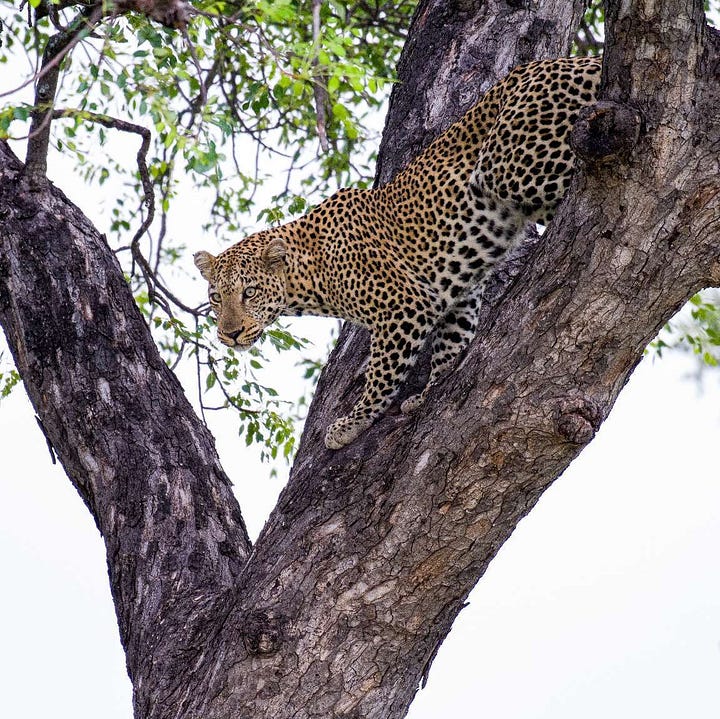Monthly newsletter - January 2024
From a very rare sighting to the launch of new safaris
Dear supporters and contributors,
This month, I bring you exciting news on several fronts, from a rare discovery to the launch of a truly unique safari experience.
A Strawberry Surprise in the Waterberg
My heart skipped a beat when the Ant Collection team reported an incredible sighting in the Waterberg: a female leopard with two cubs. This their first sighting ever logged on the mobile app since they joined the project. But what makes this sighting very special? One cub is boasting a captivating strawberry coat! This erythristic, or "strawberry," leopard cub marks the first such sighting for our project. It is also only the eleventh documented in South Africa since 2012!
Have a look at the two reported sightings in 2023 in Welgevonden Game Reserve (also in the Waterberg) and in iSimangaliso Wetland Park in Kwa-Zulu Natal.
Dr. Tara Pirie, former Ingwe Leopard Research manager, sheds light on this unique phenomenon in her publication:
Fur Color Variation: Leopards exhibit a range of coat colors across various regions, likely influenced by vegetation types and light levels.
Genetic Cause: The strawberry cub's unique coloration stems from a rare recessive mutation in the agouti gene, leading to increased phaeomelanin (yellow-red pigmentation).
Conservation Implications: While speculative, erythrism could potentially serve as a visible indicator of population fragmentation and decline, highlighting the need for continued monitoring.
Data Analysis: Delving Deeper
Thanks to our partnership with Transfrontier Africa, we are excited to welcome a new student who will delve into analyzing leopard data. This replaces the previous student who, unfortunately, faced technical issues. We eagerly anticipate the initial results of this research, which aims to:
Understand the environmental variables influencing leopard distribution patterns.
Pre-process leopard presence data and environmental variables for statistical analysis.
Generate spatial maps depicting leopard distribution patterns.
I am also exploring innovative ways to analyze citizen science data. I recently discover that another researcher is already implementing similar analysis for her research so I am looking forward to learn further from her. Stay tuned for future updates!



AI: Conservation's Best Asset
Not all leopard sightings translate perfectly into identifications on the African Carnivore Wildbook platform. Black & white camera trap images, nighttime sightings, and partial views often pose challenges. But fear not! The more images we upload, the better the AI becomes at finding matches and identifying individual leopards.
The recent upload of 70+ ID kits from the Kruger National Park significantly boosted identification accuracy. Here's how our "temporary ID" system works:
Partial Picture, Complete Identity: For leopards with incomplete pictures, I assign temporary IDs based on available information (e.g., right flank matching one another). Once I obtain more images, I can complete identity kit (including shots from all sides) by merging these temporary IDs, creating a comprehensive picture.


For that individual leopard, I only had right flank images. A citizen scientist had a sighting and took pictures of the left and right flank of a leopard and I was finally able to give a permanent ID to that leopard.
AI to the rescue: The HotSpotter algorithm plays a crucial role. It automatically detects and identifies leopards, saving countless hours compared to manual analysis. Additionally, AI can identify subtle pattern similarities invisible to the human eye, minimizing identification errors.
Join me in the field!
I am excited to announce two new initiatives that offer unique ways to become a part of our mission:
Volunteer Program: Applications are opening soon for our highly selective volunteer program, offering opportunities to contribute directly to our research efforts.
Guardian Safaris with On Track Safaris: Embark with me on a 10-day safari in South Africa, visiting reserves partnering with Ingwe and meeting three inspiring conservation partners. Subscribe now for full program details!
Here is a glimpse of one of the 7 itinerary we offer: click here.



Your support is vital to our mission of protecting leopards and their habitats. Subscribe to our newsletter for exclusive updates and opportunities to get involved. Share about our work with your social circle to embark them in exciting new adventures! We also welcome donations if you wish to help us extend our reach and protect more leopards.




